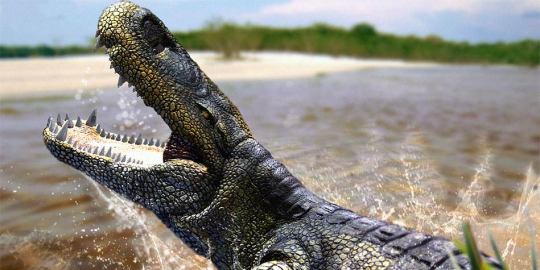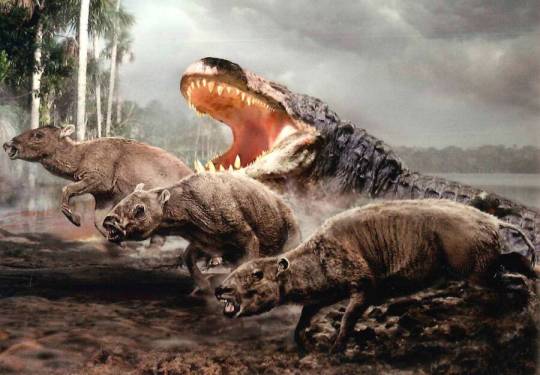#huayquerian
Text

Thylacosmilus atrox, an extinct metatherian mammal that superficially resembles the saber-toothed felids, but is instead related to modern marsupials.

#art#digital art#paleoart#chordata#mammalia#mammals#sparassodonta#thylacosmilidae#thylacosmilus#thylacosmilus atrox#miocene#huayquerian#montehermosan#pliocene#south america
21 notes
·
View notes
Photo






Research: Purussaurus
What is this: Purussaurus is an extinct genus of giant caiman that lived in South America during the Miocene epoch, from the Friasian to the Huayquerian in the SALMA classification.
Facts about it:
1. There were three types of monster croc at the end of Miocene, with Purussaurus being one of them.
Its huge size put a number of constraints on it For one it needed a great deal of food to fuel its bulk, without its prey and the animal started to dwindle.
In a rapidly changing world, the animal’s very size had become its handicap.
The age of South America’s giant reptiles had ended for good and the terrifying likes of Purussaurus or its kin would never return.
2. The Purussaurus and the Tyrannosaurus lived in different ages, but there is no doubt that the Purussaurus would have won a fight between the two of them, said co-author Aline Ghilardi.
However, purussaurus wasn’t terribly long for this world.
Also according to Ghilardi, the region’s geological movements spurred the tectonic growth of the Andes mountains and eventually led to the creature’s demise.
3. The head of this giant caiman was about 5 feet long, almost as long as the entire body of most caiman species existing today.
The robust head had big, sharp teeth, which helped it grip and hold on to its prey. The teeth vary slightly between the species but are generally about 2 inches long and slightly curved backward.
The nature of the fossil skull suggests that this animal’s bite force was massive enough to perforate the prey’s bones and shatter their internal organs.
What did I learn from this: By taking ideas from this croc it can guide me to what crocodile I want to design within the F.M.P.
1 note
·
View note
Note
Turns out the birds aren't birds at all. Want to know what they are? Lean down, and I'll tell you… Lower, lower now… They're fingers!

Argentavis magnificens was among the largest flying birds ever to exist, quite possibly surpassed in wingspan only by Pelagornis sandersi, which was described in 2014. A. magnificens, sometimes called the Giant Teratorn, is an extinct species known from three sites in the Epecuén and Andalhualá Formations in central and northwestern Argentina dating to the Late Miocene (Huayquerian), where a good sample of fossils has been obtained.
3 notes
·
View notes
Text
Neoepiblemidae - Wikipedia
The Neoepiblemidae are an extinct family of hystricognath rodents from South America. The genera Dabbenea and Perumys, formerly placed here, are now included in Phoberomys.[1] The delimitation of the present family and the Dinomyidae is in need of review; some genera in the latter (such as Phoberomys and Eusigmomys) are sometimes included here.
Fossils of the family were found in the Colhuehuapian to Huayquerian Pinturas, Sarmiento, Santa Cruz, Cerro Bandera and Ituzaingó Formations and Colhué Huapí Member of Argentina, the Solimões Formation of Brazil, the Pebas Formation of Peru and the Urumaco Formation of Venezuela.[2]
References
Bibliography
Horovitz, Inés, Marcelo R. Sánchez-Villagra, Thomas Martin and Orangel A. Aguilera (2006): The fossil record of Phoberomys pattersoni Mones 1980 (Mammalia, Rodentia) from Urumaco (Late Miocene, Venezuela), with an analysis of its phylogenetic relationships. Journal of Systematic Palaeontology 4 (3): 293–306.
Further reading
Kramarz, A.G. 2001. Revision of the family Cephalomyidae (Rodentia, Caviomorpha) and new cephalomyids from the early Miocene of Patagonia. Palaeovertebrata 30(1-2):51-88.
McKenna, Malcolm C., and Bell, Susan K. 1997. Classification of Mammals Above the Species Level. Columbia University Press, New York, 631 pp. ISBN 0-231-11013-8
0 notes